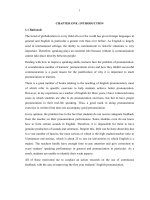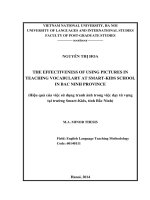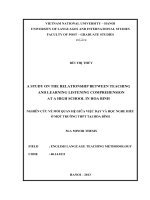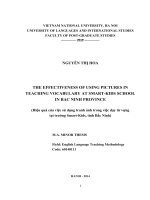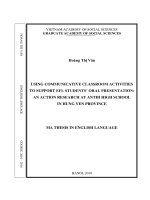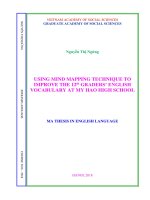An action research study on using social networking site to improve the tenth grade students’ vocabulary at a high school in nam dinh province
Bạn đang xem bản rút gọn của tài liệu. Xem và tải ngay bản đầy đủ của tài liệu tại đây (2.13 MB, 111 trang )
VIETNAM NATIONAL UNIVERSITY, HANOI
VIETNAM NATIONAL UNIVERSITY, HANOI
UNIVERSITY OF LANGUAGES AND INTERNATIONAL STUDIES
UNIVERSITY OF LANGUAGES AND INTERNATIONAL STUDIES
FACULTY OF POST - GRADUATE STUDIES
FACULTY OF POST - GRADUATE STUDIES
*********************
*********************
VŨ THỊ HUẾ
VŨ THỊ HUẾ
AN ACTION RESEARCH STUDY ON USING SOCIAL NETWORKING
AN ACTION RESEARCH STUDY ON USING A SOCIAL
NETWORKING SITE TO IMPROVE THE TENTH GRADE
AT AVOCABULARY
HIGH SCHOOL INAT
NAM
DINH PROVINCE
STUDENTS’
A HIGH
SCHOOL IN NAM
DINH PROVINCE.
SITE TO IMPROVE THE TENTH GRADE STUDENTS’ VOCABULARY
(Nghiên cứu cải tiến sư phạm về việc sử dụng một mạng xã hội để cải thiện từ
(Nghiên cứu cải tiến sư phạm về việc sử dụng một mạng xã hội
vựng của học sinh lớp 10 ở một trường THPT tỉnh Nam Định)
để cải thiện từ vựng của học sinh lớp 10 ở một trường THPT tỉnh Nam Định)
M.A. PROGRAMME THESIS
M.A. PROGRAMME THESIS
Field: English Teaching Methodology
Code: 8140231.01
Field: English Teaching Methodology
Code: 16045220
HANOI – 2018
HANOI – 2019
VIETNAM NATIONAL UNIVERSITY, HANOI
UNIVERSITY OF LANGUAGES AND INTERNATIONAL STUDIES
FACULTY OF POST - GRADUATE STUDIES
*********************
VŨ THỊ HUẾ
AN ACTION RESEARCH STUDY ON USING SOCIAL NETWORKING
SITE TO IMPROVE THE TENTH GRADE STUDENTS’ VOCABULARY
AT A HIGH SCHOOL IN NAM DINH PROVINCE
(Nghiên cứu cải tiến sư phạm về việc sử dụng một mạng xã hội
để cải thiện từ vựng của học sinh lớp 10 ở một trường THPT tỉnh Nam Định)
M.A. PROGRAMME THESIS
Field: English Teaching Methodology
Code: 8140231.01
Supervisor: Nguyen Thu Hanh, Ph.D
HANOI – 2019
DECLARATION
I declare that this thesis, which I submit to University of Languages and
International Studies, is my own personal effort. I have faithfully and accurately
cited all my sources, including books, journals, handouts as well as any other
media, such as the Internet, letters or significant personal communication.
I declare that I understood the concept of plagiarism and I acknowledge
my thesis will be rejected in case of plagiarism.
i
ACKNOWLEDGEMENTS
It is a pleasure to thank many people who made this dissertation possible.
I would like to express my deepest gratitude to my supervisor Ms. Nguyen Thu
Hanh for her valuable guidance, precious advice, and constructive criticism. I
thank her for her understanding and encouragement. I wish to address my sincere
thanks to the head of English division of University of Languages and
International Studies, Viet Nam National University. I owe my thanks also to all
the teachers who have accepted to fill in the interview, and special thanks are due
to the students of grade 10 students in my school for their time to fill in the
questionnaires, answer the interview and do the tests.
ii
ABSTRACT
In the context of Vietnam, most high school students only study English
in traditional classrooms. However, with the development of technology, using
social networking sites, especially Facebook, may be a new trend in coming
years. With the deep concerns about this situation, the researcher conducted a
study titled “An action research study on using social networking site to
improve the tenth grade students’ vocabulary at a high school in Nam Dinh
province”. This study was an action research project which was carried out to
improve students’ vocabulary knowledge by using a social networking site:
Facebook. The main purpose of this study was to find out the influence of
Facebook on students’ learning vocabulary process. The participants were 94
students in grade 10. To collect the data for this research, quantitative and
qualitative method were used. Questionnaires, interviews and tests were
employed to triangulate the information from various aspects to ensure the
validity and reliability of the research. The results showed that students’ scores
improved after they joined in the research. Additionally, Facebook also
motivated the students to study not only at school but also at home. In short,
Facebook had a positive influence on the students’ learning vocabulary process
so that the students felt interested in learning English vocabulary. Basing on
these findings, some suggestions for using of Facebook to teach English were
mentioned in the paper. Therefore, the paper would be a good reference for
researchers, teachers and students to have a closer look on the issue and enhance
students’ vocabulary knowledge.
Key words: vocabulary, social networking sites, Facebook, English
vocabulary
iii
LIST OF FIGURES
Figure 1:
Steps of teaching English vocabulary ( Marzano, 2004)
Figure 2:
Five essential steps of learning new words (Brown and Payne,
1995)
Figure 3:
A Facebook personal site
Figure 4:
Action research steps adapted by Susman (1983)
Figure 5:
An online lesson
Figure 6:
Data collection procedure
Figure 7:
Data from questionnaire and test analysis procedure
Figure 8:
Data from interview analysis procedure
Figure 9:
Students’ reasons for learning English vocabulary
Figure 10:
Students’ learning means
Figure 11:
The amount of vocabulary learnt in a week
Figure 12:
Students’ purposes for using Facebook
Figure 13:
Students’ attitudes towards learning on Facebook
Figure 14:
Students’ test score improvement
Figure 15:
Diagnostic test result
Figure 16:
Final achievement test result
Figure 17:
Test results
Figure 18:
An exercise to revise student vocabulary learning
iv
LIST OF ABBREVIATIONS
EFL:
English as a Foreign Language
FL:
Foreign Language
L1:
First Language
SNSs:
Social Networking Sites
LIST OF TABLES
Table 1:
Classification of the items in the two questionnaires
Table 2:
Classification of the items in the semester tests
Table 3:
Classification of the items in the pre- test and post- test
Table 4:
Classification of the items in the interview questions
Table 5:
Vocabulary delivered to students through Facebook
Table 6:
Students’ studying places
Table 7:
Table 8:
Students’ strengths and weaknesses in learning English vocabulary at
the beginning of the research
Students’ strengths and weaknesses in learning English vocabulary at
the end of the research
Table 9:
Places for students to study English vocabulary
Table 10:
Advantages of using Facebook for educational purposes
Table 11:
Disadvantages of using Facebook for educational purposes
v
TABLE OF CONTENTS
DECLARATION……………………………………………………………..
i
ACKNOWLEDGEMENTS………………………………………………….
ii
ABSTRACT…………………………………………………………………..
iii
LIST OF FIGURES…………………………………………………………..
iv
LIST OF ABBREVIATIONS………………………………………………..
v
LIST OF TABLES……………………………………………………………
v
TABLE OF CONTENTS…………………………………………………….
vi
CHAPTER 1: INTRODUCTION…………………………………………...
1
1. Rationale of study…………………………………………………………..
1
2. Aims and objectives of the study…………………………………………...
2
3. Research questions………………………………………………………….
3
4. Scope of the research……………………………………………………….
3
5. Significance of the study……………………………………………………
3
6. Hypotheses………………………………………………………………….
3
7. Research methodology……………………………………………………..
4
8. Structural organization of the study………………………………………..
4
CHAPTER 2: THEORETICAL BACKGROUND………………………..
6
1. Overall view of English vocabulary………………………………………
6
1.1. Definition of English vocabulary………………………………………………
6
vi
1.2. Types of English vocabulary……………………………………………………
7
1.3. The importance of vocabulary in learning a language……………………..
8
2. Teaching and learning English vocabulary…………………………………
9
2.1. Teaching English vocabulary…………………………………………………..
9
2.1.1. Principles of teaching vocabulary…………………………………………
9
2.1.2. Steps of teaching vocabulary……………………………………………….
10
2.2. Learning English vocabulary…………………………………………………..
12
2.2.1. Principles of learning vocabulary………………………………………..
12
2.2.2. Steps of learning vocabulary…………………………………………….
12
2.3. Problems in teaching and learning English vocabulary…………………
15
3. Facebook as a social networking site………………………………………
17
3.1. Definition of Facebook……………………………………….……………….
17
3.2. Advantages and disadvantages of using Facebook for educational
purposes………………………………………………………………………….
18
3.2.1. Advantages of using Facebook as an educational tool……………..
19
3.2.2. Disadvantages of using Facebook as an educational tool...............
20
4. Previous studies…………………………………………………………..
21
4.1. Previous studies overseas…………………………………………………….
21
4.2. Previous studies in Vietnam…………………………………………………..
23
Summary………………………………………………………………………
23
CHAPTER 3: RESEARCH METHODOLOGY…………………………...
25
1. Design of the study…………………………………………………………
25
1.1. Action research……………………………………………………………….
25
1.2. Mixed methods…………………………………………………………………
27
vii
2. The setting of the study………………………………………………….
27
3. Participants……………………………………………………………….
28
4. Data collection instruments……………………………………………….
29
4.1. Questionnaires……………………………………………………………………
29
4.2. Tests………………………………………………………………………………
30
4.2.1. Pre- test (diagnostic test)…………………………………………………..
32
4.2.2. Post- test (final achievement test)…………………………………………
32
4.3. Interview…………………………………………………………………………
32
5. Data collection procedure…………………………………………………..
34
6. Data analysis method……………………………………………………….
40
6.1. Quantitative Analysis Strategy…………………………………………………
40
6.2. Qualitative Analysis Strategy………………………………………………….
41
Summary……………………………………………………………………….
42
CHAPTER 4: FINDINGS AND DISCUSSION…………………………….
43
1. Questionnaires……………………………………………………………..
43
1.1. Students’ overall view on learning English vocabulary ………………….
43
1.1.1. Students’ reasons for learning English vocabulary……………………
43
1.1.2. Students’ strengths and weaknesses in learning vocabulary………….
44
1.1.3. Places for students to study vocabulary………………………………….
47
1.1.4. Students’ learning means……………………………………………………
48
1.1.5. The amount of learnt vocabulary…………………………………………..
50
1.2. Students’ overall view on learning through Facebook……………………..
51
1.2.1. Students’ purposes of using Facebook…………………………………..
51
viii
1.2.2. Students’ perception of learning on Facebook……………………
53
1.2.3. Advantages of using Facebook for educational purposes…………..
54
1.2.4. Disadvantages of using Facebook for educational purposes……..
55
2. Tests ………………………………………………………………………..
56
3. Interview…………………………………………………………………...
60
3.1. Student’ comparison of their learning vocabulary process………………
60
3.2. Students’ perception of ease and difficulty of using Facebook ………….
61
3.3. The usefulness of Facebook as a learning tool……………………………..
62
3.4. Students’ attitude towards learning English vocabulary on Facebook….
63
4. Discussion………………………………………………………………….
66
Summary……………………………………………………………………...
68
CHAPTER 5: CONCLUSION……………………………………………...
70
1. Recapitulation……………………………………………………………..
70
2. Implications ……………………………………………………………….
70
3. Limitations of the research………………………………………………
71
4. Suggestion for future research…………………………………………..
71
REFERENCES……………………………………………………………..
73
APPENDICES………………………………………………………………
I
ix
APPENDIX 2…………………………………………………………………
V
APPENDIX 3…………………………………………………………………
IX
APPENDIX 4…………………………………………………………………
XV
APPENDIX 5…………………………………………………………………
XXI
x
CHAPTER 1: INTRODUCTION
In this part, the problem and the rationale for the study, together with the
objectives and the scope of the whole paper, are clearly stated and explained.
Above all, this part also builds the research questions to work as clear guidelines
for the whole research.
1. Rationale of study
During the whole teaching period, the researcher has recognized that most of
her Vietnamese students encounter several problems in learning English. One of the
biggest problems seems to come from their lack of vocabulary, which leads to their
lack of confidence in English learning. Students use language to express their ideas,
opinions and thoughts so it is impossible to communicate with the other without
vocabulary. Limited vocabulary repertoire strictly forbids students from expressing
fully and precisely their opinion.
Learning English vocabulary is an important area, which takes a great deal
of time and effort to gain. Working as an English teacher, the researcher always
emphasizes teaching vocabulary because of its importance in language learning.
Vocabulary is needed for expressing meaning and in using the receptive (listening
and reading) and the productive (speaking and writing) skills. Despite its
importance, many students tend to not focus on it. As a result, they cannot deal well
with their exam (even written or oral), which leads to their results not as good as
teachers expected. From personal point of view, there are some reasons for students
to not acquire extensive vocabulary in English (their FL). Firstly, many teachers are
not confident about their practice in vocabulary teaching and at times they do
not know where to begin to form an instructional emphasis on word learning.
Besides, because of the teaching time limitation, vocabulary is a minor part of a
lesson; therefore, it is not focused in class. Last but not least, students have many
subjects and homework to do after school so that they spend little time studying
1
English, especially vocabulary at home.
In Vietnam, English becomes more and more popular. It is the foreign
language that is compulsory in schools: from primary schools to universities.
Vocabulary is one of the aspects which is needed to master four skills: listening,
speaking, reading, and writing. To motivate students to study vocabulary, some
English teachers and instructors have started to use social media to instruct students
to study foreign language (FL) vocabulary. Social media is strong motivation for
students’ engagement because students will find it fun and relax to learn vocabulary
and enjoy their time.
Nowadays, Facebook seems to play an important role in social life so that it
could meet an educational need. Several studies investigate using different
technologies in learning and teaching, especially teaching foreign language.
However, rare studies explored the role of Facebook in learning foreign languages,
particularly learning vocabulary. This study attempted to assess the effectiveness of
using Facebook in enhancing vocabulary of students in grade 10 at a high school in
Nam Dinh province. 94 students were exposed to the use of Facebook as an
environment to learn and enhance their vocabulary. Then, the students were given
test, interview and questionnaire to assess their achievement after 9 weeks of using
Facebook as an educational tool for learning English vocabulary.
2. Aims and objectives of the study
The purpose of this paper is to determine benefits of using a social
networking site: Facebook in teaching English. More specific purpose is to explore
how learning English through Facebook affects students’ achievement in
vocabulary at a high school in Nam Dinh province and whether Facebook can
enhance students’ vocabulary. The general purpose can be categorized into some
specific aims as follows:
• To investigate students’ attitudes towards using social networking sites for
educational purpose;
2
• To investigate the advantages and disadvantages of using Facebook as an
educational tool;
• To give recommendations for teachers and students to overcome the
vocabulary related problems.
The result of this study, hopefully, will improve students’ vocabulary
storage. It is also for teachers to deploy social media, especially Facebook, into
their teaching.
3. Research questions
The study attempts to answer the following questions:
(1) To what extent does using Facebook affect students’ English vocabulary
learning?
(2) What are the students’ attitude towards the deployment of Facebook in
teaching and learning English vocabulary?
4. Scope of the research
This study only focuses on the actual situations related to using Facebook to
enhance students’ vocabulary knowledge.
5. Significance of the study
This study is noticeable for students because through learning on the
Internet, EFL students may get an exciting way to study vocabulary. It is also
important to the teachers, who may be encouraged to used social media in their
classroom as a teaching tool to motivate students to get into learning new words.
6. Assumptions
To answer above questions, the researcher hypothesizes that:
• Facebook is an additional tool for students to learn vocabulary.
• Students who learn English via social networking sites (include Facebook)
will be more inclined to improve their vocabulary.
3
• Learning vocabulary via social networking sites (Facebook) is more
effective than in traditional classes.
7. Research methodology
In carrying out the study, action research was used. Mills (2011) states
action research is systematic inquiry done in teaching or learning environment to
gather information. Based on the definition above, it can be concluded that action
research is the systematic study of efforts to overcome educational problems.
• The choice of method
The research was designed as an action research study, which provided
solutions for teaching vocabulary at high school. In this case, the researcher
adopted both quantitative and qualitative approaches. The researcher used mixed
method with the application of three types of data collection: questionnaires, test
results and interview.
• Research tools
To gather reliable data for this study, researcher collected the results of
some vocabulary tests in class. In addition, two questionnaires were designed for
students at the beginning and at the end of the course. The third tool used in the
study was an interview which was adopted in the last week of the research.
8. Structural organization of the study
Finally, to guide for either researcher in writing the research paper or
readers in reading the whole contents of the research paper, the researcher sets up
the order of the paper as follows:
Chapter 1: Introduction - provides rationale of the study, aims and
objectives, questions, significance, hypotheses and research methodology of the
study.
4
Chapter 2: Theoretical background – presents an overall view of relevant
literature on the issue of using a social networking site (Facebook) to improve
students’ lexical knowledge.
Chapter 3: Research methodology- provides a description of the research
methods, selection of the participants, data collection instruments, data collection
procedures as well as data analysis methodology.
Chapter 4: Findings and discussions - presents the results of the study and
the discussion of the results.
Chapter 5: Conclusion- summarizes the main points of the study, draws
some conclusions, points out the limitation of the study and makes some
suggestions for further research.
To sum up, the elaborations have not only justified the major contents and
structures of the study but they also work as the guidelines for the rest of the paper.
5
CHAPTER 2: THEORETICAL BACKGROUND
In this chapter, the importance of vocabulary in learning English as a
foreign language will be discussed. It also covers the definition and types of
vocabulary, steps of teaching and learning vocabulary and some problems in
teaching English vocabulary as a foreign language. Besides, it shows the overall
view of social networking sites as well as Facebook. This chapter also reviews the
previous studies on the use of social networking sites in teaching languages,
especially the application of Facebook to teach and learn vocabulary.
1. Overall view of English vocabulary
1.1. Definition of English vocabulary
Vocabulary is an essential part of every language. Hatch and Brown (1995,
p.2) define vocabulary is all the words of a specific language that the speakers of
this language might use. Many authors have the similar definitions about
vocabulary. Taylor (1990, p.32) states that vocabulary is the total stock of words
belonging to a branch of knowledge or known by a person. Zimmerman (2007,
p.19) also recommends that vocabulary acquiring is leaning a collection of words in
a target language that are used in a specific context. He also emphasizes that the
lexicon of a language is its vocabulary, which involves words and expression. This
means that without firm vocabulary base, comprehension and utilization of the
language cannot be accomplished. Herrel (2004, p.25) enhances Zimmerman’s
definition further by suggesting that lexicon organizes the mental vocabulary in an
individual’s mind, which means that a speaker’s mental lexicon is that person’s
knowledge of vocabulary. Some other authors have more complicated definitions
about vocabulary. Richards (2000, p. 400) defines vocabulary as a group of words
containing single words, compound words and idioms. He also emphasizes that
vocabulary is a group of words of a particular aspect of foreign language learning
and teaching. Words mean the memory of the situation in which they have been
observed and understood, brought out by the context they are used, which means
6
that to be familiar with a word is to be able to use or understand it in a situation in
which the speaker has not experienced it before. Additionally, Nation (2001, p.22)
says that vocabulary knowledge involves understanding a word in the spoken form
of the word and the spoken form can be understood in and out of context rather
than guessed. Besides, Zimmerman (2007, p.115) suggests that vocabulary is a set
of words that are the fundamental building blocks adopted in the generation and
understanding of sentences.
From all the definitions above, it can be concluded that vocabulary is the
total number of words that are needed to communicate and express idea and
thoughts. In brief, what all the definition above have in common is that vocabulary
knowledge is not only the meaning knowledge but also the use of words in a
particular context.
1.2. Types of English vocabulary
Vocabulary is variously classified into some kinds. Hatch and Brown (1995,
p.25) recommend two different types of vocabulary, named receptive vocabulary
and productive vocabulary. Receptive vocabulary is the words that students
recognize and understand when it is put in a specific context, but they cannot
produce it correctly. Students can recognize these words when they appear in a
reading or listening context, but they do not use them in speaking and writing.
Therefore, leaning receptive vocabulary is also considered as a passive process
because the students only receive thoughts from the others. In language application,
receptive vocabulary is stated as the fundamental vocabulary, which is much more
enormous than productive vocabulary. Productive vocabulary, in contrast to
receptive vocabulary, is the words that students understand and can pronounce
correctly in speaking and writing. It includes all the receptive vocabulary and the
abilities to speak or write at the right time. As a result, learning productive
vocabulary can be addresses as an active process. It means that to use productive
vocabulary, students must be able to pronounce it correctly, use grammar of the
7
target language accurately, and understand the connotation meaning of the words.
Nation (1990, p.98) divides vocabulary into two types according to their
basis of frequency: low frequency vocabulary and high frequency vocabulary. High
frequency vocabulary includes words widely used in a particular language. It is
often used for all four skills: reading, writing, speaking and listening and across the
full range of situation of use. Low frequency vocabulary; meanwhile, consists of
only small percentage of the contemporary words, which means that low frequency
words are hardly used in language.
Brown (1994, p112) states that vocabulary can be divided into four types,
which are content words, function words, substitute words and distributed words.
Content words are used to describe the names of subjects or things, such as: doctor,
lawyer, engineer; action done by those things like: heal, protect, work; and the
qualities of these things like: wonderful, boring and patient. Function words are
used to express the relation of grammar, such as conjunction: and, but, so and
auxiliary, such as: do, does, did. Substitute words are used to represent substitutes
for whole formed classes of words, such as: nobody, everybody, and somebody.
Distributed words are used to present the negative, such as: any, either or neither.
From the explanation above, it is easy to understand that every author is
different in categorizing types of English vocabulary. In this research, content and
high frequency words, such as nouns, verbs and adjectives, are concerned. The kind
of material for teaching vocabulary is narrative texts related to the topics that
students study in the textbook because they are interesting for students to achieve
new vocabulary and new information.
1.3. The importance of vocabulary in learning a language
The importance of vocabulary has been mentioned by many scholars. Amer
(2002, p.1) claims that vocabulary is the centre of a language and critically
important to the specific learners. In addition, Burton & Humpries (1992, p.40)
argues that “development of lexical knowledge of lexical knowledge occupies an
8
important position in the learners’ struggle to master a second/ foreign language”. It
means that not only learning second languages but also learning foreign languages
has closely connected to the total number of vocabulary students acquires.
Additionally, many authors agree that vocabulary is the main item for effective
communication. Ediger (1999, p.1) clarifies “conversation carried on with the other
persons requites vocabulary”. It means that the more vocabulary an individual has,
the more possibly he can express his ideas. He also adds that various selections of
words to convey the meaning is fundamental for speaking and writing skills and
diverse terms in productive skills improve the quality of communication.
Additionally, Shedding says that the writers should use vocabulary that the readers
can understand and that are suitable with rhetorical matters. Furthermore, Carl
(2003) supports that a good writing is mainly relied on the author’s ability to use
words to describe an event. Nunan (1999, p.103) believes that people
living
abroad and those trying to master the target language find that studying vocabulary
is much more essential than grammatical structures.
In short, learners cannot improve their target language if they do not spend
time increasing vocabulary. They can develop the language by focusing on words
and their expressions. It means that a person can enable their communication
without the correct use of grammatical rules when vocabulary is available.
2. Teaching and learning English vocabulary
2.1. Teaching English vocabulary
2.1.1. Principles of teaching vocabulary
Many students find it difficult to learn vocabulary because they are living in
non- native environment. Teachers; therefore, must pay much attention to both
“what to teach” and “how to teach”. There are many challenging to for teachers to
teach students FL vocabulary, such as what kinds of methods to use how many
words to teach or what kind of vocabulary should be taught. Schmitt (2000, p.146)
points out that there are 8 main principles in teaching vocabulary to guide students
9
learn, memorize and use the words, which are:
• Building a large sight of vocabulary
• Integrating new words with previous words
• Providing number of encounters with a word
• Promoting deep level of processing.
• Facilitating imaging
• Making new words “real” by connecting to the students’ words in some
ways
• Using various techniques
• Encouraging independent learning strategies
As mentioned at the beginning, there is no standard to judge which is the
best way or even the right way to teach vocabulary. It depends on many areas, such
as: the level of students, the school curriculum or the students’ major. However,
teachers should follow the basic principles to provide students with new words.
2.1.2. Steps of teaching vocabulary
As mentioned above, teaching vocabulary is very important for all four
language skills. Scholars show many different ways to teach vocabulary. One of the
nearest and most popular theories used to clearly point out teaching 6 steps is
Marzano’s theory published in 2004. It can be summarized as follows:
• Step 1. Explaining
In this step, teachers are expected to provide students with clear description,
explanation, or example of the new terms. There are many ways to introduce them
to the students, such as: telling a story, using video or computer images as a source
of information, using a current event to connect the term to something familiar.
• Step 2. Restating
The following step is to ask students to restate the descriptions, explanations
10
or examples in their own words. In means that in spite of simply copying from what
teachers have said students have to get their own descriptions, explanations or
examples. Students can keep these descriptions, explanations or examples in their
private notebook.
• Step 3. Showing
The next step is requiring students to produce a picture, symbol or graphic
representation of the term. In this step, students are encouraged to think of the term
in a different way. It requires students to process information in nonlinguistic ways.
• Step 4. Discussing
In this step, students are encouraged to join in discussion activities that help
them to improve their knowledge of the words they have learnt. Students can
compare and contrast the term, classify terms, identify synonyms and antonyms,
which can help them to add or revise the entries in their vocabulary notebooks.
• Step 5. Refining and reflecting
The next step requires students to return their notebooks to refining and
reflecting entries. Students may do it in pairs or in groups by comparing their
description of the terms or explaining to each other any new information they have
learnt or new thoughts they have had since the last time they review the terms.
• Step 6. Applying in Learning Games
The last step requires teachers to involve students in learning games that
allows them to play with the terms. Many types of games can be organized to keep
the new terms in the forefront of the students’ thinking. Steps to teach English
vocabulary can be summarized as in Figure 1 bellow:
Step 1. Explaining
Step 2. Restating
Step 3. Showing
Step 4. Discussing
Step 5. Refining and
reflecting
Step 6. Applying in
Learning Games
Figure 1: Steps of teaching English vocabulary (Marzano, 2004)
11
In short, to teach vocabulary for students, many steps should be applied. In
addition, teachers also need to depend on students’ proficiency to choose which
steps should be emphasized more.
2.2. Learning English vocabulary
2.2.1. Principles of learning vocabulary
In learning language vocabulary, many students find it difficult to choose
what to learn or how to learn. As a result, teachers should deliver to students some
principles for studying vocabulary. They can guide students to use these principles
for acquiring vocabulary of target language. Schmitt, N. (2000, p75) suggests five
principles for learning language as follows:
• Guessing words from the context, which refers to the ability to infer the
meaning of an expression using contextual clues
• Using word parts techniques to remember words
• Using vocabulary cards to remember foreign language- first language word
pairs
• Seeing words in different and multiple contexts
• Keeping a vocabulary notebook
There is no affirmation whether which principle is the best or the most
important; however, from my point of view, students should combine more than
one technique.
2.2.2. Steps of learning vocabulary
Learning vocabulary is a fundamental thing in order to master all the four
skills: reading, writing, speaking and listening. As Thornbury (2002, p.2) points
that “without grammar very little can be conveyed, without vocabulary nothing can
be conveyed”, English teachers should focus on developing students’ vocabulary.
One of the most important aspects to develop their vocabulary is self- study.
According to Harmer (1991, p.2) students are experience some considerable
12

